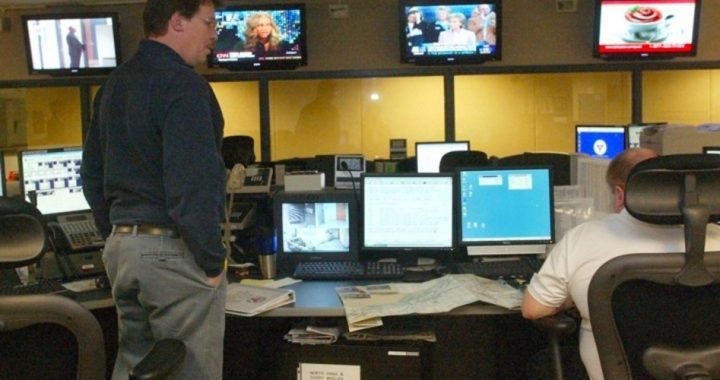
In order to sweeten the pot of federalization, the Department of Homeland Security (DHS) is giving gifts of expensive gadgets to local police forces.
Cops in North Jersey, for example, were showered with gifts from their would-be overseers. As reported by The Record:
Oradell, Emerson, Closter and Harrington Park police have car-mounted night-vision technology and video and recording equipment that can watch over the Oradell Reservoir and dam — and the hikers and anglers entering it. West Milford can do the same around the Newark watershed. Wayne police are scanning … the license plates of vehicles outside the Willowbrook Mall, while East Rutherford officers patrol hotel parking lots near the Meadowlands and the Federal Reserve building off Route 17.
How is all this new technology being used? Who is being watched? Why are they being targeted for surveillance? Neither law enforcement nor federal agents are talking.
When contacted by The New American, the DHS representative in New Jersey refused to answer these questions, saying that revealing what information is being collected, how long it will be stored, or who will have access to it would threaten national security. Of course.
The web of surveillance being woven by the Department of Homeland Security among local law enforcement agencies is part of the secretive effort known as the Buffer Zone Protection Program. According to DHS:
The Buffer Zone Protection Program (BZPP) is a Department-administered infrastructure protection grant program to help local law enforcement and first responders identify and mitigate vulnerabilities at the highest-risk critical infrastructure sites. A buffer zone is the area outside a facility that an adversary can use to conduct surveillance or launch an attack. The term is associated with identified critical infrastructure and key resources (CIKR).
BZPP provides funding to local law enforcement for equipment acquisition and planning activities to address gaps and enhance security capabilities. The program brings together private sector security personnel and first responders in a collaborative security planning process that enhances the buffer zone.
Local police who participate in the program will have access to a shockingly broad array of personal information of citizens. Facial recognition technology, license plate readers, and stop light camera video feeds will all be funneled to a Regional Operations Intelligence Center where FBI, police, and DHS agents can watch the live feeds. These hubs are part of a larger operations complex known as a Fusion Center.
The following information is taken from a fact sheet on fusion centers posted on the DHS website: “A fusion center is a collaborative effort of two or more agencies that provide resources, expertise and information to the center with the goal of maximizing their ability to detect, prevent, investigate, and respond to criminal and terrorist activity.”
A description of the functioning of these incubators for the forthcoming federal police force is also provided on the DHS site:
State and major urban area fusion centers (fusion centers) serve as primary focal points within the state and local environment for the receipt, analysis, gathering, and sharing of threat-related information among federal, state, local, tribal, and territorial (SLTT) partners…. Fusion centers conduct analysis and facilitate information sharing, assisting law enforcement and homeland security partners in preventing, protecting against, and responding to crime and terrorism.
The literature promoting the acceptance of fusion centers lists several ways the new federal agency will impose its will on the formerly autonomous and accountable police chief or county sheriff.
First, the feds will decide where and when to deploy local police department personnel. The chief, if he still exists, will be no more than a functionary required to make sure that the orders of the federal government are carried out. More likely than not, these new missions, in addition to preventing crime in the city or county, will engage in the collection of information about and apprehension of those local citizens identified by a committee in Washington as posing a threat to national security. Consider the revelation in 2009 that Homeland Security’s Office of Intelligence and Analysis released a document entitled “Rightwing Extremism: Current Economic and Political Climate Fueling Resurgence in Radicalism and Recruitment,” which listed war veterans, anti-abortion activists, small-government advocates, and those concerned about immigration as terrorist risks.
Second, DHS (or whichever one of the federal agencies eventually takes over law-enforcement duties) will train new recruits. Policies, procedures, and purposes will not reflect traditional (and constitutional) goals of law enforcement, but will be tailored to training officers to perform those duties associated with the new, national emphasis of the force, with a slant toward federalism.
Finally, funds for this conversion from local police department to outpost of the federal law-enforcement agency will be provided by the bureaucrats on Capitol Hill. This carrot will be tied to the stick of federal control.
So far, the DHS has marked 1,849 locations scattered throughout the 50 states that will serve as regional surveillance collection centers. As part of the department’s 2010 budget $48 million was spent establishing the centers. As The Record reports, “in Bergen and Passaic, 18 police departments have received federal grants totaling nearly $1.4 million since 2005 for equipment to watch over more than a half-dozen North Jersey locations.”
There is a major constitutional obstacle to such constant monitoring of citizens — the Fourth Amendment. The Fourth Amendment reads:
The right of the people to be secure in their persons, houses, papers, and effects, against unreasonable searches and seizures, shall not be violated, and no warrants shall issue, but upon probable cause, supported by oath or affirmation, and particularly describing the place to be searched, and the persons or things to be seized.
Such sweeping surveillance technology does not conform to the constitutional requirement that all searches be reasonable and be conducted with warrants based on probable cause.
Given the power of the tools being brought by DHS into cities and towns as they take effective control of local law enforcement, it is difficult to determine who is being watched, why they are being watched, and who is doing the watching.
Again, The Record reports:
State officials won’t say how long the surveillance information is kept, but the ACLU [American Civil Liberties Union] argues that license plate scans, for example, could be kept indefinitely. In late July, the group filed public records requests with 21 New Jersey police departments seeking information on how they are using automatic license plate readers.
“The American people have a right to know whether our police departments are using these tools in a limited and responsible manner, or whether they are keeping records of our movements for months or years for no good reason,” the ACLU said in a statement.
Apparently, the people’s elected representatives are being kept in the dark, as well. An investigation by The Record discovered that DHS officials preferred preventing local elected leaders from discovering the full extent of the surveillance being carried out by the Fusion Centers as part of the Buffer Zone Protection Program. Freedom of Information Act petitions requesting such information have been rebuffed by the DHS.
The Record reports on the futile efforts by town leaders to pull back the shroud covering the covert federal/local law enforcement collaboration:
In West Milford, the police chief asked the Township Council last fall to authorize spending for a covert surveillance camera program, funded through the Homeland Security grant. When council members asked about its purpose, Chief Gene Chiosie said the project was meant to be secret and something “civilians shouldn’t know.”
“You know what concerned me: When I asked how the cameras were going to be used, I was just told ‘It’s part of Homeland Security,’?” said former Councilman Daniel Jurkovic, who resisted the purchases. “Not everything that is right for the federal government is right for the citizens of West Milford.”
From the DHS, to the NSA, to the federal courts, every branch of the federal government is stretching the surveillance net to cover all Americans and to place us under the never-blinking eye of Big Brother so that no act of defiance will escape recognition and reprisal.
And now, with the Buffer Zone Protection Program and the Fusion Centers, the Obama administration is bribing local law enforcement to participate in the unconstitutional undertaking by giving the struggling agencies high-tech gifts and bags of cash, all tied like juicy carrots to the end of the stick of federalization.
Joe A. Wolverton, II, J.D. is a correspondent for The New American and travels frequently nationwide speaking on topics of nullification, the NDAA, and the surveillance state. He can be reached at [email protected].
Photo of a Fusion Center: AP Images



